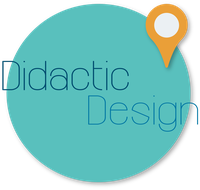Didactic Design
 |
Soon you will find further content on the topic "Didactic Design" in the area of e-learning in university teaching.
This page is constantly growing with the project and is regularly filled with new content. Unless otherwise stated, the following sources are valid: e-teaching.org • ilias.uni-giessen.de/ilias |
|
|---|---|---|
 |
Conception The production of digital teaching media is associated with certain didactic intentions, such as informing students in a targeted manner or raising their motivation, improving communication, influencing group processes and achieving greater learning success. When planning courses, therefore, the classic questions of lesson planning according to target group, content, learning objectives and teaching methods should be taken into account in the course design. (Source: https://www.e-teaching.org/didaktik/konzeption (Access: 10.09.2019 : translated by Lehre 4.0 team)) |
|
 |
Target Group When designing (partially) virtualised courses, the special needs of the target group must be taken into account. Consideration should be given to how familiar students are with computers and the Internet, whether they have the technical equipment and appropriate knowledge, and what the students expect from the course. (Source: https://www.e-teaching.org/didaktik/konzeption/zielgruppe (Accessed:10.09.2019 : translated by Lehre 4.0 team)) |
|
 |
Content When designing teaching materials, teachers are faced with the task of translating the teaching content into a comprehensible, sequential or interlinked structure. This requires professional expertise and didactic know-how.
(Source: https://www.e-teaching.org/didaktik/konzeption/inhalte (Accessed: 10.09.2019 : translated by the Lehre 4.0 team))
|
|
 |
Teaching methods A extensive repertoire of methods helps to find the appropriate approach for different disciplines and target groups. The testing of new methods can help to teach in a more target-group-oriented and motivating way and thus promoting the students' own activity. Three teaching methods can be distinguished here, which are characterized by a different degree of activation:
(Source: https://www.e-teaching.org/didaktik/konzeption/methoden (Accessed: 10.17.2019 : translated by Lehre 4.0 team)) |
|
|
Checklist | Designing digital courses The following checklist represents the recommendations for good digital teaching at JLU. It will help you to make your digital courses more activating and interesting for your students. If you design and record a structure at the beginning of the digital course, it will certainly help you to keep track of the semester and ideally also save you time and effort, such as sending weekly information e-mails or answering repeated student questions about the course and structure. |
||
|
Guide | Presentation skills in (digital) teaching/learning contexts The Department of Higher Education Didactics and Evaluation at the Justus Liebig University Giessen has published a guide to presentation competence in the (digital) teaching/learning context in cooperation with the project Einstieg mit Erfolg. The listing of important aspects of good presentation competence should help you to optimise these aspects in your (digital) course. The guide is divided into the following sections:
|
||
|
Introduction to presentation skills in (digital) teaching/learning contexts |
Expertise in the (digital) teaching/learning context |
Presentation capacity in the (digital) teaching/learning context |
| Video to be added soon | Video to be added soon | Video to be added soon |
|
Addressing the target group in the (digital) teaching/learning context |
||
| Video to be added soon |
The explanatory videos were produced by the Department of University Didactics and Evaluation at the Justus Liebig University of Giessen in cooperation with the project Einstieg mit Erfolg. Contact persons: Abteilung für Hochschuldidaktik und Evaluation
Wissenschaftliche Mitarbeiterin |
|
